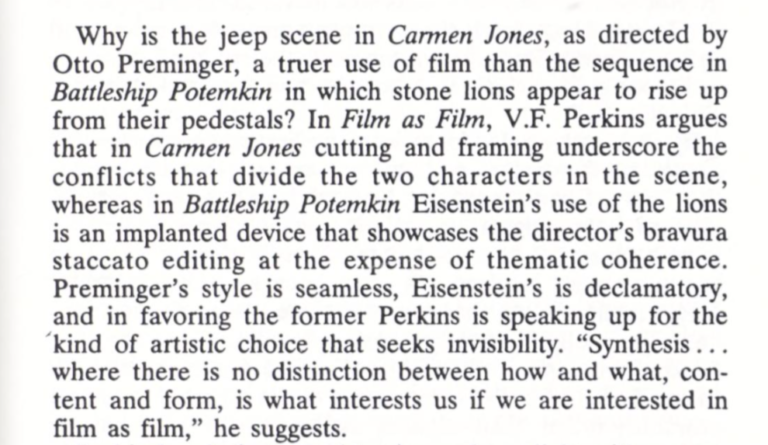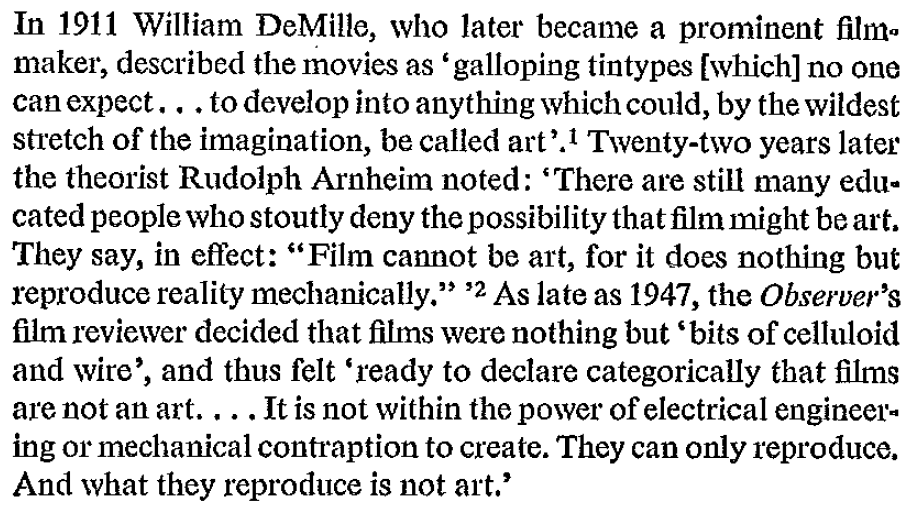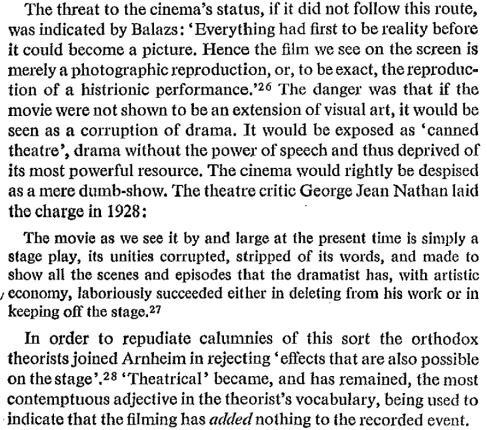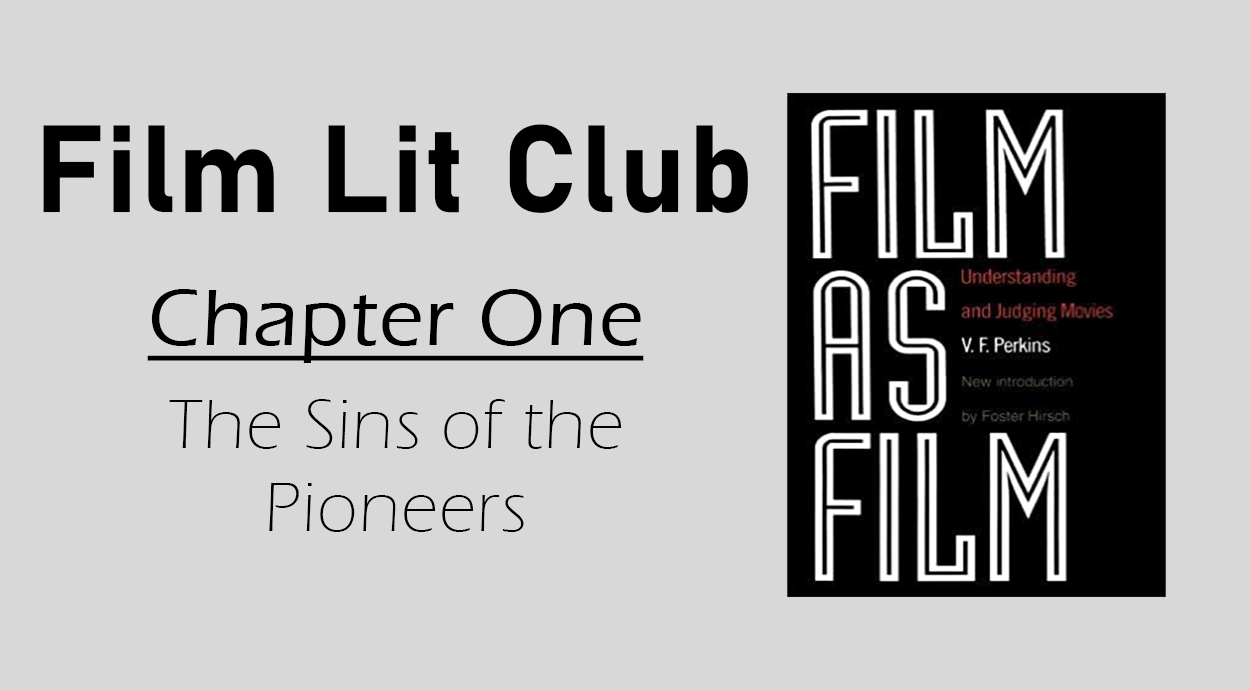Nothing gives me more inspiration for writing about movies than reading the works of other historians and film scholars. Reading both new and old ‘hot takes’ on cinema has been one of the best ways to keep the imagination and intellect flowing in film discussion and analysis. I’ve always felt a need to discuss what I’ve read, like in a book club. So today, we mark the start of the Film Lit Club, a series discussing books on (if you couldn’t guess) filmmaking.
After reading my thoughts, I invite you to share your thoughts. The objective here is to start a healthy dialogue, whether it’s over my analysis or the reading itself. I want some engagement around here! Aren’t you tired of the same old “debates” on Twitter; Scorsese vs. Marvel? Booooring. The wrong movie won Best Picture at the Oscars? I’ve heard that one before (though it’s still enjoyable in some cases). Comment on the bottom of the post here what you think about this week’s reading, a well-suited introduction to film theory: V.F. Perkins’ 1972 book Film as Film.
For the last few weeks, between my time at work and on other projects, Perkins’ writing has re-engaged my mind with intriguing topics within film theory. His work stands out because he doesn’t speak in academic rhetoric that flies over our heads or retread over tired subjects discussed by others. Film as Film utilizes “commonsensical” language to describe his claims and perspective, giving a casual feel that will ease any newcomer into the literary world of film analysis.
Whether you’re a casual moviegoer or a devotee, you have some thoughts on what plays on the silver screen. In Film as Film’s first chapter, we are greeted with a history lesson on the film industry pioneers pushing for cinema to be accepted by ‘intellectuals,’ in part of a critical debate of whether putting film on the artistic pedestal did more harm than good.
If you don’t have a copy of the book (my edition features an introduction from an old professor of mine, Foster Hirsch), I highly recommend picking it up on Amazon or buying it used from ThriftBooks or eBay. Here’s a link to a digital library version you can borrow freely, but it’s not the most reliable if multiple users seek it out. Additionally, here’s a link to a downloadable file; the scan is a bit iffy but better than nothing. Otherwise, I’ll attach specific selections for my thoughts. So without further ado, let’s start with the following…
Introduction
Foster Hirsch, a professor at Brooklyn College and acclaimed film noir historian, wrote this introduction for the book’s re-release in 1993. If you had any anxiety from reading such a popular and canonical book, let Hirsch’s appraisal put you at ease.

Starting with a summary of an eye-catching argument posed by Perkins in a later essay, Hirsch hooks you, the reader, with Perkins’ wild assertion. A one-sentence preview of the assertion in the blurb on the back cover is not enough. Hirsch knows this is a provocative claim for anyone familiar with these movies. Surely a sequence from Battleship Potemkin edited by the pioneer of editing, master of montage Sergei Eisenstein, must be more ~~cinematic~~ than a mere car scene in Preminger’s Carmen Jones; not according to Perkins, who Hirsch notes as preferring “invisible” over blatant editing/cinema techniques.
Hirsch then goes right into the selling point of Perkins’ work: his unpretentious writing style. Hirsch is enthused by the “language of refreshing clarity, directness, and simplicity” I was praising earlier. Hirsch asserts that the assumption that intellectual discussion on any subject, let alone film, must be conducted with convoluted patois harms the actual point of debate. Following that up, he writes that the works of acclaimed theorists like Christian Metz, Roland Barthes, and even Laura Mulvey, while deserving of recognition for their contributions to film theory evolution, have irrevocably muddled the textual landscape of film studies with “daunting, punishing style.”
I’m in agreement with Hirsch on this. While essential to a complete understanding of film theory and the more complex studies of their impact on politics and psychology, those works are mostly inaccessible to a casual enjoyer of the medium. This stirs an eternally raging argument of how much the layman can learn about media and culture before it’s no longer learning at his leisure but a committed academic undertaking. I believe everyone can benefit from some enlightenment on cinema’s true power wielded over us. But these readings are not without repeated glances, as Hirsch points out:

According to Hirsch, attempts to follow in Barthes’ verbose footsteps have led to dissuasion in tackling critical essays on film; Perkins was a pioneer and peer to many of these theorists and critics, yet maintained a “limpid style that promotes rather than silences dialogue” that his colleagues did not.
If that isn’t enough to sell you on Perkins, Hirsch notes something else that sets Perkins apart from his contemporaries. Perkins believed that cinema can have its cake and eat it too, that there is no “pure” film or a singular purpose the motion picture was meant for. Many theorists argued for realism or illusion, that the motion camera was designed explicitly for recording, and that fantasy/fiction films go against this “true purpose.” Film as Film broaches this subject later, but knowing where Perkins stands is essential. Knowing this informs us on his critical ability and his preferences for film-watching, as someone who believes film can be anything we make it to be; Hirsch quotes him, “The fiction movie exploits the possibilities of synthesis between photographic realism and dramatic illusion.”
I implore you to read the whole intro by Hirsch. Nothing is more important than knowing how fellow film scholars feel about other academic work. Hirsch puts his heart on his sleeve in his delight for Film as Film.
Chapter One: The Sins of the Pioneers
There are obvious, well-debated injustices that haunt filmmaking past (some still at work today). Racial and gender inequalities are still being addressed, both above and below the line. Perkins, rather than retread the subject or speak on something he feels no place to stand, refers to an unobserved transgression: the mistakes made when elevating the film to its present-day level of esteem in the art world.
It isn’t easy to imagine a time when movies weren’t a revered form of artistic expression, not unlike painting or book writing. With awards seasons across the international community and numerous outlets devoted to film appraisal (or apathy, when it is suitable), it seems like there was no “battle for prestige,” and film appreciation wasn’t a struggle to achieve the moment the Lumiere Brothers displayed the first cinematograph.

The fact that there can be cited sources indicating that the motion picture’s place in the art world wasn’t codified so soon after its innovation into what we know as a ‘film’ astounds me. “As late as 1947”?; Do you mean even with acclaimed releases like Gone With the Wind, the original A Star is Born, and The Wizard of Oz, there were those in the post-war era that saw film as entertainment and nothing more? Bewildering!
He paints a nuanced picture of this world that I shouldn’t be able to recognize. Quotes from the early history of film books round out these first couple of introductory paragraphs before getting to Perkins’ cause, his reason for rallying these excerpts. He raises a few concerns about the effect on film comprehension – the way we perceive film – due to the industry’s coerced promotion of the film to levels of high art.
As a relatively modern film theorist, I feel like this following line broaches a little on Perkins himself. He writes, “The theorist’s concern with prestige severely limited his freedom to…speculate on the nature of the movies. His definitions had to be such that they appealed to the conventionally cultured mind.” There’s a line of connection to be made between early theorists clinging to the codified structure of classifying art, allocating it to motion pictures, and Perkins’ break-away from fellow analytical writers in his manner of text.

Perkins’ argument delves into the playing of devil’s advocate at specific points, going against the established tomes of art appreciation and assessment. While it’s easy to look back and say that there was a better way to put the film on its deserved pedestal, it’s well to be aware of the rashness people go through when a good thing comes along. I feel that by not wanting to squander the potential of cinema financially and artistically, the pioneers (none of whom get named, by the way; it’s a very general title) went for the objectively straightforward route by comparing this new art form to other art forms.
Wouldn’t that be your first idea? You’ve got a new thing that has the potential to stand amongst long-standing things of a similar vein; wouldn’t you draw lines of parallel to those things to bring a sense of recognizability to the new something? (Metaphors are complicated, aren’t they?)
In his assertion, Perkins supposes two things: one, that “we could derive the criteria appropriate… from a description of Art so broad as to include drama, music, novels…” and second, “that the theory of art is not itself problematic.” Again, an intriguing hook that will catch the eye! But is it accurate to question the integrity of art theory? A process of breaking down and rebuilding conventions based on the presentation of new modes of expression does have its roots in neglecting underrepresented points.
Art, in my opinion, has the paradoxical ability to be both objective and subjective. We understand the subjective already; it’s called taste, personal preference, and knowing what we as individuals like. It’s the objective part that the theory has often struggled to wrangle, and cinema is not without its faults in that line of questioning.
As far as context goes, Perkins goes to great lengths to attach the artistic shift into post-impressionism to the moving picture’s transfer from “fascinating scientific curiosity” into its early form of mass entertainment. It’s not a new connection, as he cites an art historian’s record of this event. However, it’s still a well-written presentation, seamlessly understood by someone like me who has no understanding of painted, sculpted, or illustrative art. Overcoming this hurdle of the film camera being seen as merely a scientific tool rather than a creative force is again a perspective I hadn’t really thought of.

In this particular passage, the “route” he’s referring to is the demonstration, the proof, that motion pictures are not just capturing reality but creating their own through the combined art of editing and composition. Now, suppose you’ve seen many early films rapidly pushed out by industry starters like Edison at Biograph or even the celebrated Melies’ earlier work. In that case, you’ll have some idea of these films’ ‘theatrical’ look. Looking as though it were a filmed stage show was not the way to bring the movie to higher acclaim; this is the point Perkins makes here.
Back to those sins, we read further into just how detrimental those attachments to ‘the ways of old’ were as the pioneers attempted to stick to the status quo of recognizable art mode. Filmmakers were trapped in this hole of working to the standards of still imagery, negating the essence of motion pictures and capturing movement. With the Russian-perfected theory of montage having a significant effect on the edited form, the industry got the pushing-off point needed to show that they were part of a creative force. But Perkins notes that a more significant component to elevating film was the fantasy aspect, the creation of reality rather than its recording. Movies like The Cabinet of Dr. Caligari and A Trip to the Moon used the camera in such ways to depict what Perkins consistently connotates as mystique that audiences and intellectuals couldn’t help but begin to delegate the status of art to the cinema.
The Sins of the Pioneers makes Perkins’ point on the disjointed evolution of film theory to match the industry’s yearning for prestige very clear. Rather than dictating its terms of being an art form, pioneers conformed to what Perkins calls antiquated canon that “defines” Art. While you can’t take back this transgression, you can ponder how different things would be had events played out differently, had the elite had a different initial view of motion pictures, had there not been a gatekeep to allow the typical individual to appreciate cinema in their world.
That’s what draws me to Perkins and this book; it’s a source of perspectives that you might skip over as you are already comfortable with the state of cinema as it is now. Maybe you don’t feel the need to question how movies became an art form. But perhaps you should. After reading this first essay by Perkins alone, I think that the urge to examine and discuss should be instilled in you.
Let me know in the comments what you think of this readthrough of the first chapter in Film as Film. Any thoughts on Perkins’ work or what I had to say about it? Will you give the book a shot?

